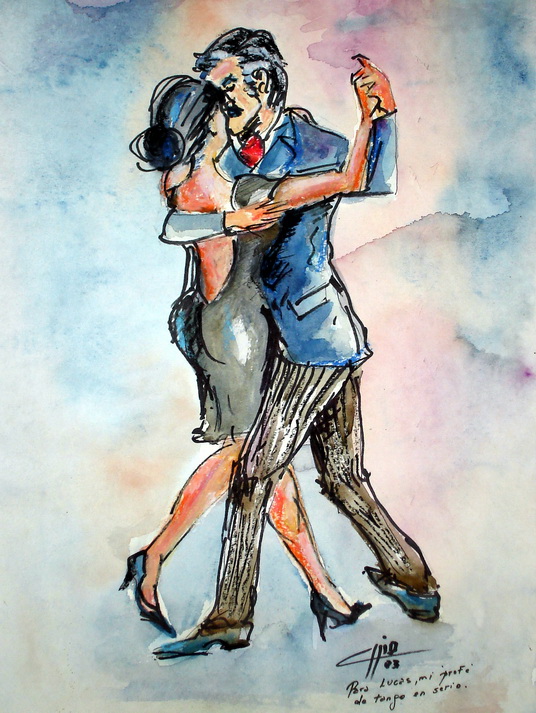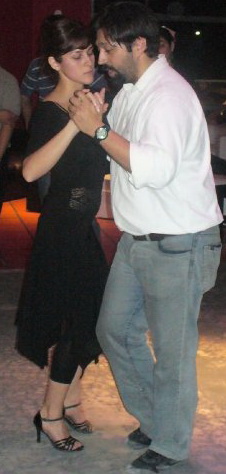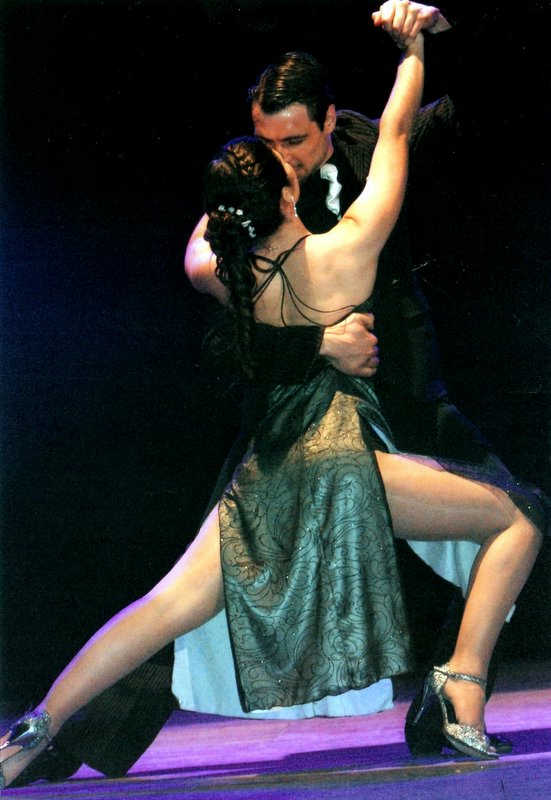|
Learn Tango in the
Heart of Argentina |
TANGO IN CENTRAL ARGENTINA
|
Learn Tango in the
Heart of Argentina |
 We
invite you to come and learn the Tango in Central Argentina with a fluent
English-speaking teacher who has been dancing and teaching for over 6 years.
RIO CUARTO is in the province of Cordoba, Central Argentina. Here you will
find friendly people in a very affordable town to relax and learn the Tango.
Argentineans are passionate about the Tango , and Rio Cuarto has a very
large University with many students who are learning to We
invite you to come and learn the Tango in Central Argentina with a fluent
English-speaking teacher who has been dancing and teaching for over 6 years.
RIO CUARTO is in the province of Cordoba, Central Argentina. Here you will
find friendly people in a very affordable town to relax and learn the Tango.
Argentineans are passionate about the Tango , and Rio Cuarto has a very
large University with many students who are learning to
 dance. LUCAS GASSE
gives private classes to individuals for a very affordable price. He can
find a partner for you. You can take two private classes a day and then join
one of the evening classes or dance sessions. Lucas can then put
you in touch with some of the Tango groups for you to practice what you have
learned. The result is that when you dance 3-4 times a day, you can learn to
dance and gain confidence in a very short time. Lucas charges 60 Pesos per
private lesson (appx US$15) and the gro dance. LUCAS GASSE
gives private classes to individuals for a very affordable price. He can
find a partner for you. You can take two private classes a day and then join
one of the evening classes or dance sessions. Lucas can then put
you in touch with some of the Tango groups for you to practice what you have
learned. The result is that when you dance 3-4 times a day, you can learn to
dance and gain confidence in a very short time. Lucas charges 60 Pesos per
private lesson (appx US$15) and the gro up lessons in the afternoon or
evening are usually free or sometimes 13 Pesos (appx US$4). Lucas can
arrange an affordable hotel in Rio Cuarto at Hotel Menossi or Hotel Opera
for about US$20-50 per night. If you have ever wanted to concentrate and
learn the Tango in a non-commercial environment with people who are
passionate, then this is the place. Email Lucas Gasse -
lucasgasse@yahoo.com.ar up lessons in the afternoon or
evening are usually free or sometimes 13 Pesos (appx US$4). Lucas can
arrange an affordable hotel in Rio Cuarto at Hotel Menossi or Hotel Opera
for about US$20-50 per night. If you have ever wanted to concentrate and
learn the Tango in a non-commercial environment with people who are
passionate, then this is the place. Email Lucas Gasse -
lucasgasse@yahoo.com.ar |
|
A
Selection of Tango Music |
|
A List of Tango Terminology |
| MILONGA | Place to dance Tango is danced. Also a musical rhythm with a faster pace than Tango - tiempo mas rapido. |
| CAMINADA | The walk - the most important element in Tango. |
| CAMINADA POR EL MEDIO (walk) | Dancer walks forward into the middle of the partner. |
| POR EL COSTADO (walk) | Male walks to the left of the partner - Deriva Izquerida. |
| COSTADO DERECHO (walk) | Male walks to the right of the partner - Deriva Derecha. |
| TRASPIE | The male stomps with back foot to change the leg. Very important in Tango. |
| OCHO ATRAS | Figure 8 backward - Female pivots with feet together and extends leg backward after the pivot. Put her on 1 foot, turn, move. |
| SANDWICH | After #2 and Female Ocho Atras, Male can Sandwich her foot. |
| ESCONDIDO | After #2 and Female Ocho Atras, Male can step over and turn, and bring woman to his side and Ocho her (Ivan maneuver). |
| OCHO ADELANTE | Figure 8 Forward - Female can ocho forward and this move is useful for the Male to perform Sacadas. |
| FLOREO | To enflower - a series of forward and backward steps - step, open, step, close - cruce adelante, apertura, cruce atras, apertura. The man can mirror (espejado) or opposite (crusado) the female steps // Repeat move twice to change between espejado or crusado. |
| CRUSADO / ESPEJADO | Cross / Mirror |
| GIRO (a la direcha, a la izquierda) | Male pivots on one foot reaching back with the other to invite partner to go around him (can be done to the right or to the left). // Three ways to walk out of a Giro: Apertura, Cruce Adelante, Cruce Atras. / Male Fwd with L, and Back and behind with R, then L foot between hers (sacada), then R between hers (sacada), then L around and hear her, then R way behind and around, then ready to put L (sacada) again. Or... walk out. // Practice both ways, so you are ambidextrous. |
| FUELLE | Useful to begin the GIRO. Male sends the partner back (side with his left then forward with his right foot) then brings her around on the other side and invites her to go around him. Also used to start the Floreo... |
| CRUCE ADELANTE | Cross forward |
| APERTURA | Open |
| CRUCE ATRAS | Cross backward |
| HAMACA | Bounce back and forth to turn or pause. Forward L, Back R, Forward L. |
| SACADA | Inserting ones leg to touch partner's leg and giving the impression that he is pushing her leg away. (start with Female Ocho Adelante and Male Ocho Adelante - backwards movement). |
| REVERSE SACADA | She makes an Ocho Adelante to the Left. The man's Left leg Ocho Atras between her legs to her thigh. Then the man's Right between her legs to her thigh. Then the man's left foot stops her. WAIT. Then step forward with the Right across to her left. Proceed to 5th step - don't traspie. (keep in your mind that when the man makes sacada, he does so at Variacion speed, while the female is at Tiempo speed). |
| BARRIDA | Sweep of your partners leg |
| SCHUFFLE | Sacada Adalante, Sacada Traspie Crusado, Sacada Adalante / Atras |
| GANCHOS | Hooks - Foot is flicked. Usually between the partner's legs. |
| A TIEMPO (timing) | On time - tiempo |
| ADAGGIO (timing) | Slow - half tiempo |
| VARIACION (timing) | Fast - twice as fast as tiempo |
| AFUERA DE EJE | Put female on Right leg and turn her. Start with both moving Left foot forward. Then the Male reaches in front and to the right next to the Female's inside right foot. She leans out to the right with his support and steps around his leg with her Left then reaches back to the left with her left. Then the male repeats. |
| APILE | Tango Hug - very close |
| GIRO MILONGUERO | Very tight Giro in confined spaces |
| QUINTO PASO | 5th step - part of the Salida Basica (go out basic). When you are walking acostado with your partner, you can traspie, her feet cross, continue. |
| REVOTE | Rebound - Hamaca is a type of Revote. Used for turning. |
| MEDIO GIRO | Reverse |
| VALDOSA | Reverse (Ivan turn). Using Hamaca to turn. |
| CADENCIA | She uses 5th step - Quinto Paso. |
| BOLEA | Man puts female on Right foot, then swings her Left leg back behind her and back through and in front of him. |
| EXTRA BOLEA | Man steps left to Apertura female, he steps with his right between her legs to connect with her Left thigh. The man then rotates the female around to the left with his chest. (must keep back straight and keep bottom in). The woman then returns drawing with her foot. She can Ocho Adelante inside man, or Man can stop her, or Man can bring her to Gancha (and bounce) on his Right leg. |
| PUENTE | Bridge - man steps away with female leaning on him. In combination with Bolea. |
| DESTAQUE | Flick her - Right leg in between her legs. Open Left, Step Forward Right and diagonal through her legs, as your pecho turns her left. It flicks her around. Not hips, chest. This is difficult. |
| DIBUJANDO | Woman drawing with her feet. |
| CHORREADA | Type of Bolea - Bring her around and spill her. |
| YEITE | A small composition of dance moves that one can pass on to others to incorporate in their arsenal. |
| LA DISONANTE | Very Difficult Ending - Lift partner up and she rolls down in your arms. Don't drop her. |
| CALESITA | Go around. Merry go round. A Giro is a Calesita. |
|
Tango Notes |
| These are comments from the teacher that provide hints and guides to students when they are learning |
|
= When you don't know what to do - Traspie = Ocho Adelante to finish the Giro = No broad base - keep feet and knees together. Bend the knees. = Many points of inflection (ankles, knees, hips, lower back, shoulders, neck) increase stability. = Man on the inside is better, because he can see where he is going and avoid bumping into other couples. = Always dance Counter Clockwise. = Do not pass people in front of you (not polite). = Do not bump into people (not polite). = Don't look down. = Don't use muscle, use invitation! = When dancing Tango - everyone looks! - stay elegant. = Guapos & Gauchos. = From the body not the feet. = Man stand tall, don't fall forward. Important in Giro. = 3 Movements: 1. Foreward, Back, Side. 2. Pivot (lift heel). Male or Female on one foot. Choose direction, take step. (Pivot, then open, 3 step. Calesita). 3. Standing Still - when done on purpose is also dancing. Always go from one step to the other with the music. |
|
Tango Videos |
|
|
Tango Shoes |
|
Places and Times of Tango in Rio Cuarto |
MONDAY: Habana Mix (Lamadrid 720). Nivel inicial 20.30 a 21.30 - Nivel avanzado: 21.30 a 22.30 - Prof: Lucas Gasse - Contactos: lucasgasse@yahoo.com.ar - 054 0358 154 247176. TUESDAY: La Casa Azul (Pringles 68) Nivel inicial 21.00 hs.Prof: Melina Camarote y Fernanda Oviedo. Contactos: melinavcam@hotmail.com 054 0358 154 226546, o_mariafernanda@yahoo.com.ar - 054 0358 154 030677 Piaff (Sobremonte esquina La Rioja) Nivel inicial 21.00 hs.Prof: Edgardo "Lalo" Giuliani. Contactos: reallalotango@hotmail.com - 054 0358 154 262649. WEDNESDAY: La Copla Arte Bar (Moreno esquina Mendoza) Nivel inicial y Avanzado 20.30 a 22.00- Prof: Lucas Gasse y Melina Camarote - Contactos: lucasgasse@yahoo.com.ar - 054 0358 154 247176, Melina - 054 0358 154 226546. THURSDAY: Universidad Nacional de Río Cuarto (Aula Taller de Arte - Campus Universitario) Nivel inicial e intermedio 14.00 a 16.00 hs. y Avanzado 1 y 2 de 16.00 a 18.00- Prof: Lucas Gasse y Melina Camarote - Contactos: Departamento de Arte dptoarte@rec.unrc.edu.ar - 054 0358 463 8002, lucasgasse@yahoo.com.ar - 054 0358 154 247176, Melina - 054 0358 154 226546. SATURDAY:Universidad Nacional de Río Cuarto (Aula Taller de Arte - Campus Universitario) Nivel Coreografico (para avanzado unicamente): 16.00 a 18.00- Prof: Lucas Gasse y Melina Camarote - Contactos: Departamento de Arte dptoarte@rec.unrc.edu.ar 054 0358 463 8002, lucasgasse@yahoo.com.ar - 054 0358 154 247176, Melina - 054 0358 154 226546 Milongas: Miercoles: Milonga C Abierta: La Copla Arte Bar (Moreno esquina Mendoza) de 22.00 a 03.00 hs. Entrada gratuita - Contactos: lucasgasse@yahoo.com.ar - 054 0358 154 247176. Domingos: Milonga / Show : La Copla Arte Bar (Moreno esquina Mendoza) de 21.30 a 01.30 hs. Entrada: $10 - Contactos: lucasgasse@yahoo.com.ar - 054 0358 154 247176. |
|
|
| www.argentinapolo.com/tango.html om/tango. |